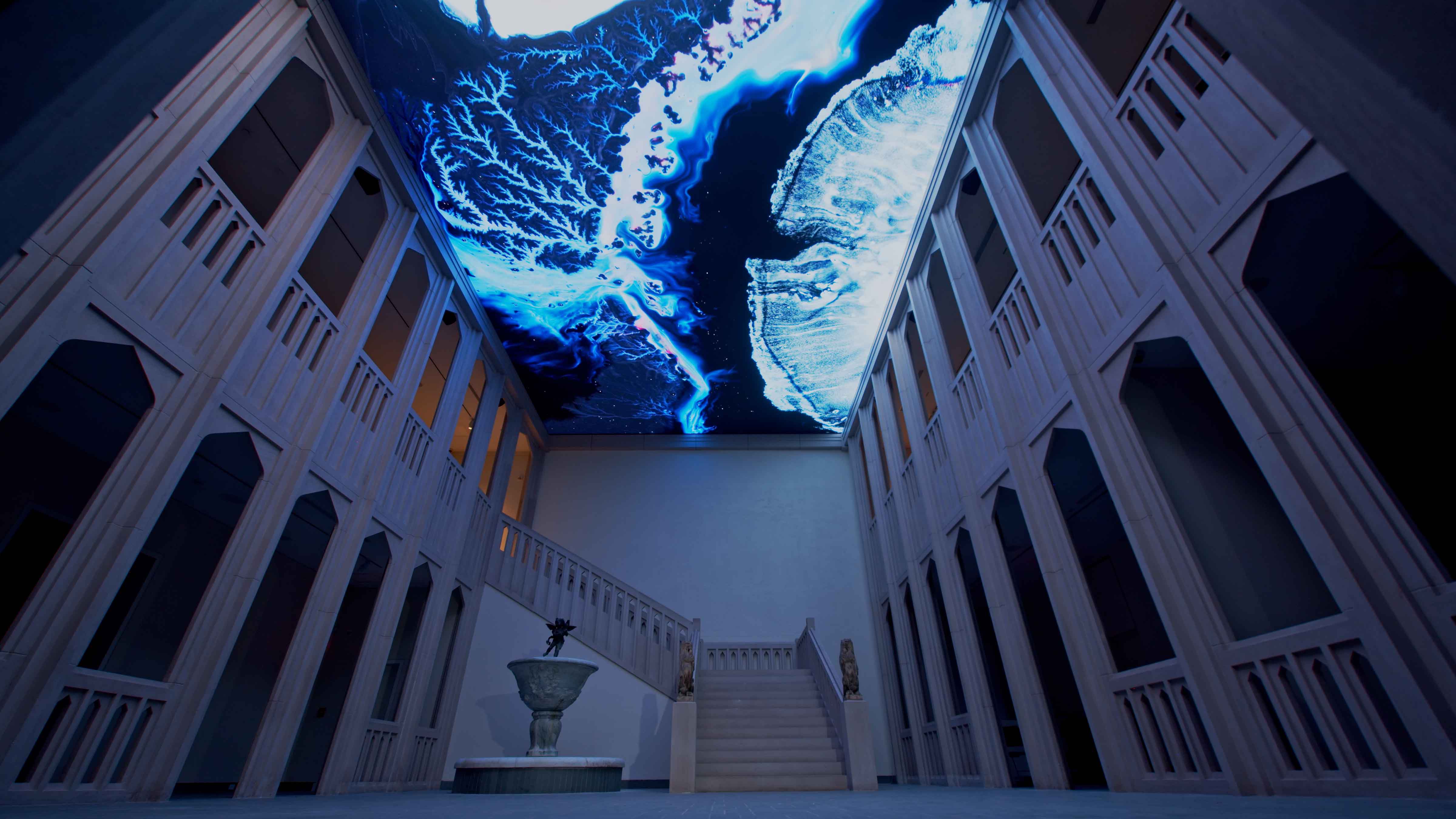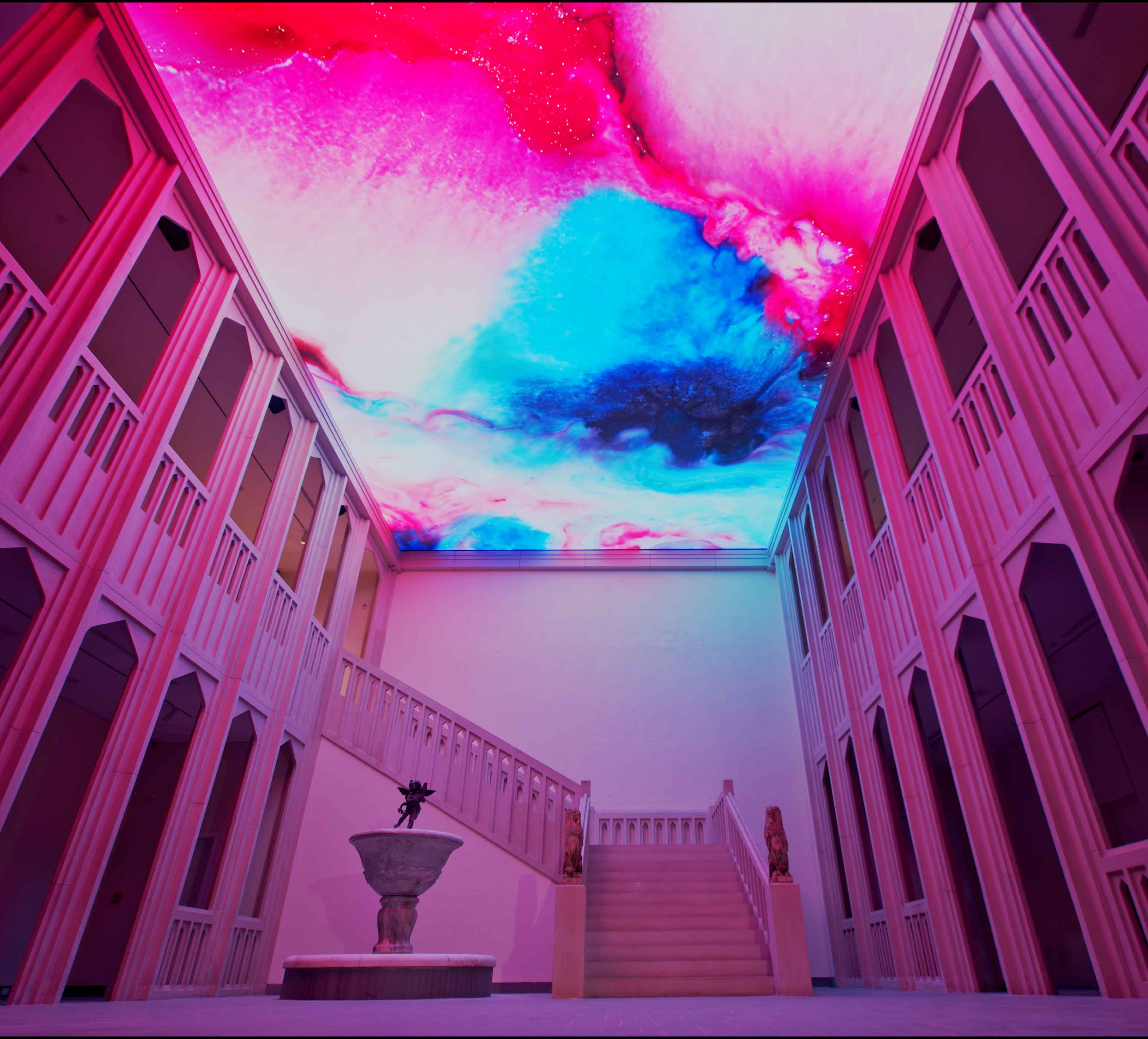Above It All
The Clowes Pavilion at the Indianapolis Museum of Art: Newfields is not just an event space—its dvLED ceiling display is a work of art.

Indianapolis Museum of Art: Newfields, one of the premier arts organizations in the Midwest, took the opportunity during a recent renovation to blend technology, art, and design—on the ceiling.
Through the installation of 522 Neoti dvLED panels on the ceiling of the Clowes Pavilion, the museum created an immersive, engaging experience that has all visitors with their eyes toward the sky. Officially unveiled in March, the museum wanted the indoor courtyard to seamlessly connect to their other art galleries while having the ability to stand alone as a unique venue for outside rentals and events.
The collaborative undertaking began when the museum engaged with Blockhouse Studios, an innovator in cutting-edge mixed media technologies and design, and integrator AVI Systems to decide if some of the initial ideas and concepts were rooted in a semblance of reality. Blockhouse was a familiar partner for the museum, having led projection mapping for its Fall Harvest Show. As a result, the company was an ideal partner to conceptualize a gathering space that leaves a lasting emotional impact while being a space for true artistic exploration.

Blockhouse approaches everything as content creators first, but the company knows technology. “We see how to use these tools and use them right,” said Kevin Winkler, owner of Blockhouse Studios. “When we’re selling LED to the client, it’s not just because it’s our product, it’s because it’s the right thing for that project.”
No Projection Mapping
The museum had originally wanted to use projection mapping on the ceiling—but when Blockhouse reviewed the plan, it was immediately clear it was not a possibility. Creating a membrane, or projection mapping screen, large enough for the ceiling was just not feasible, with many leading manufacturers of projection mapping membranes unwilling to tackle the project.
No one ever says, 'Nice canvas.' It’s about what you put on the canvas. That should be an early consideration in these projects.
Kevin Winkler, Blockhouse Studios
Due to gravity, the membrane would naturally sag over time. There was no way to keep it as tight as it would need to be, along with other variables concerning the projectors and mapping of content that would not meet the expectations the museum had for the project. To guarantee the screen would meet standards concerning durability, brightness, and color accuracy, it became clear that dvLED would be the ideal solution.
A daily selection of features, industry news, and analysis for AV/IT professionals. Sign up below.
With that in mind, Blockhouse received a competitive bid from locally-based LED provider, Neoti, and began discussions of selecting the right product from them. Neoti has a diverse offering of LED products; Joe Kipfer, lead technician with Neoti, said it became clear that the power-efficient and lightweight 2.5mm UHD Series would provide a smooth image without pulling a lot of power—and meeting all weight and safety requirements.
[Extron Enhances Capabilities at the Dallas Holocaust and Human Rights Museum]
“I think that for 2.5mm for the height that you’re at, it’s perfect,” said Winkler. “It’s going to hold up for a long time. It looks super clear and bright.” Winkler said they may have been able to get away with using 4mm, but with the entire project centered upon quality, he wanted a product that matched that. Blockhouse worked to ensure the budget would allow for the 2.5mm product, no matter what.
Exacting Installation Details
Once the product was selected, the team had to move to the more daunting task of installing what would later become an 11,500-pound, 47x31-foot dvLED structure. “If you look at the final video wall, it looks like the room was built around it,” said Kipfer, who also handles all 3D drafting for Neoti. “That’s how tight it fits. To get it to fit that tightly, you have to put it in a 3D modeling software and just make sure that everything is going to work out correctly.”

LED is not often installed on a ceiling—but when it is, the install process becomes more complicated. Kipfer explained there are some unique requirements for a project where LEDs panels are above people’s heads with the picture facing down toward them. Gravity obviously brings added safety concerns; each panel had to be customized, beyond the specialty type of panel that was selected, to include safety cables to avert anything that is loose or can be removed from falling below.
The ceiling has steel structural beams, but it was not possible to mount the panels directly because it would make the display too tall. Everything had to be lowered with steel cable, allowing the steel beams to take the full weight. At the bottom of the steel cables, pipes were laid out in a grid and the panels were attached directly to the pipes using customized brackets.
Every detail had to be exact, from how many brackets were needed to the placement of the brackets, and requirements were tightened to ensure the safety of people below the display. Installing more than 500 panels at this elevation was no easy task, and not one the team wanted to do individually using a lift. During the installation process, scaffolding was brought in to basically create a false floor and make the install process more efficient. Additional partners were brought in for the install process, including Dodd Technologies, and 3D models were constructed to ensure that every element of the install would work.

Any required maintenance is conducted on Mondays while the museum is closed, making it less of a safety risk compared to when visitors are present. Technicians use an electric lift that goes all the way to the ceiling. So far, there have been no failures within the network, just the replacement of a handful of diodes. The panels also have rear maintenance capabilities, if needed, it’s usually easier to work on the panels from the front. A custom Mac OS solution keeps the content running smoothly, and the audio system features one-touch automation.
All About Content
With content creation at the core of Blockhouse's process, Winkler said the technology is really cool, but you have to have something really stunning to put on screen. “We’re a little different,” said Winkler. “I think this is something that is really emerging and important in the industry. For a while, these types of screens became more popular, and people install these giant screens. No one ever says, 'Nice canvas.' It’s about what you put on the canvas. That should be an early consideration in these projects. What are you putting on these screens, and how are you going to make this an actual, legitimate art install? Just a multi-million-dollar screen isn’t going to get you there.”
[Rust Never Sleeps ... and Neither Do Display Manufacturers]
When designing the content, Blockhouse leaned on VR, building the pavilion out, and allowing the museum to test content for a greater sense of scale and perspective within the actual space, something you wouldn’t get from just viewing an image on a screen. This made it very clear, for Blockhouse and the museum, what content would and would not work within the space.
Content ranges from drone shots of the campus, including its exquisite gardens and grounds, and fluid art pieces that allow for the natural elements of color to shine through, making you wonder what you’re exactly seeing. For added impact, the content is paired with an emotional soundscape curated by Andy Beargie, Blockhouse audio engineer.
“This makes you feel,” said Winkler. “You don’t get that with every install.”
Jennifer is a freelance writer and marketing consultant based in the New York City area. Within the AV industry, Jennifer loves to explore how technology can alter the world around us, creating immersive experiences unlike any other. She has years of experience working with AV integrators, manufacturers, and event production companies in developing engaging content to increase their overall awareness.

